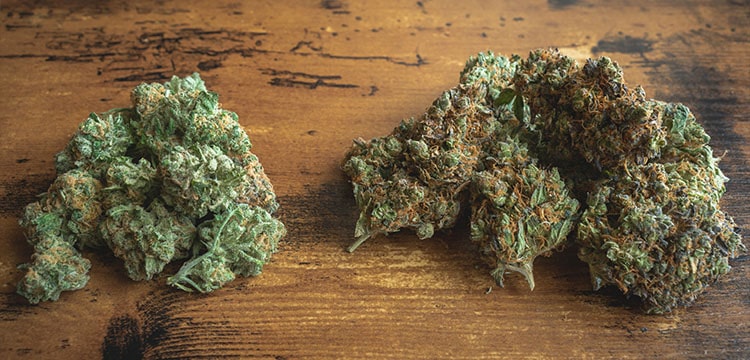Strains, cultivars, extracts, flower — does it ever feel like you need a dictionary to sort through all of the different terms used in a marijuana dispensary? Luckily for you, we’ve done all the hard work and made you an easy-to-read guide about two of the most important marijuana terms: indica and sativa. We’ll go over what they mean and how to find the perfect cannabis product for you.
Indica vs. Sativa
Like coffee, marijuana plants are categorized by their species and region of origin. The two main kinds are Cannabis sativa and Cannabis indica, and they’re split up based on their physical characteristics. Sativa plants are tall and skinny with light, narrow leaves, while indica plants are short and bushy with dark green leaves.
Sativa strains tend to have higher levels of THC, which is responsible for the euphoric, high effect that marijuana is famous for. Indica strains, on the other hand, usually have higher levels of CBD. CBD provides inflammation and pain relief without the psychoactive effects of THC.
Traditionally, sativa is used for its invigorating and energizing effects that are helpful in reducing anxiety and increasing focus. Indica is recommended for its full-body relaxation effects and to reduce insomnia.
There are also types of marijuana known as hybrid strains, which are bred by growers by combining parent plants of indica and sativa to create new varieties of marijuana.
The Lowdown on Sativa
Sativa is naturally found in places with hot, dry climates, like Africa and Central Asia. They can grow as high as 12 feet, and tend to take a little longer to grow than indica or hybrids do. Sativa is stimulating, so it’s recommended that you take it during the day. Two of the most well-known strains are Acapulco Gold and Panama Red.
The Lowdown on Indica
Indica is native to Afghanistan and Turkey, and it thrives in harsh climates. They grow faster and have a higher yield than sativa plants typically do. Indica is recommended for nighttime use because it is so relaxing. Two of the most well-known strains are Hindu Kush and Afghan Kush.
Chemovars: The New Kid In Town
These days, it’s actually growing more uncommon for budtenders to use the terms indica, sativa and hybrid to categorize different marijuana strains. Now, marijuana is sorted into different “chemovars,” or breeds. The chemovar lets professionals organize weed into three types:
- Type I: high THC
- Type II: THC/CBD combined
- Type III: high CBD
Chemovars are defined by the different levels of cannabinoids and terpenes that are inside. Cannabinoids and terpenes are chemical compounds that give a strain its specific effect, flavor and aromas. Some cannabinoid examples are:
- THC is the main psychoactive compound found in cannabis. It’s what’s responsible for that high or euphoric feeling.
- CBD doesn’t cause a high and is used for pain relief and management.
- CBG is thought to help reduce symptoms of anxiety and depression.
- THCA is similar to THC but doesn’t cause any psychoactive effects. It’s thought to help with inflammation.
Terpenes are compounds that affect how chemovars smell. Some common terpenes include:
- Bisabolol has notes of chamomile and is thought to have antimicrobial effects.
- Linalool has floral notes and is used as a mood booster.
- Myrcene is the most common terpene and has earthy, herbal notes.
- Pinene has an intense pine aroma and is thought to reduce nausea.
- Limonene has bright citrus notes.
- Eucalyptol has a refreshing scent and is used to reduce inflammation.
Depending on what your goals are for your marijuana consumption, the budtender can help identify the perfect chemovar for you.
How To Choose the Right Strain for You
The nice thing about marijuana is that, because there are so many new types being grown and produced every day, you’ll be able to find one that tailors perfectly to your goals. As a general rule, you’ll want to pick Type I chemovars if you’re looking for more of a head high, Type III if you want more pain relief without the high, and Type II if you are looking for a middle ground. Your budtender will know exactly what to recommend to you.
Questions To Ask Your Budtender
Before going to the dispensary, think about what your goals are. Are you hoping to use marijuana for pain relief or as a sleep aid, or are you looking for something recreational? Do you want more invigorating effects or something to help relax you? Or, maybe you are using cannabis to help with your anxiety.
Budtenders know everything there is to know about marijuana, and they love talking to customers, both new and returning, about the latest and greatest in the cannabis industry. Don’t worry about taking a long time or asking too many questions, because you can’t — not in a dispensary! The whole point is to help you feel comfortable and confident in your purchasing decisions.
From indica to sativa and everything in between, there’s a cannabis variety that’s perfect for you — and your local dispensary can’t wait to help you find it.

